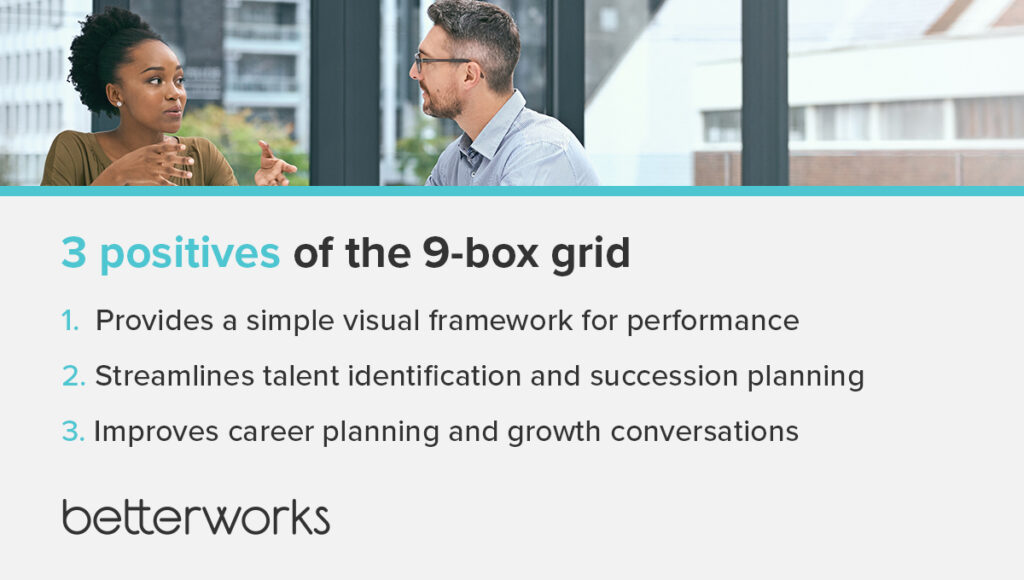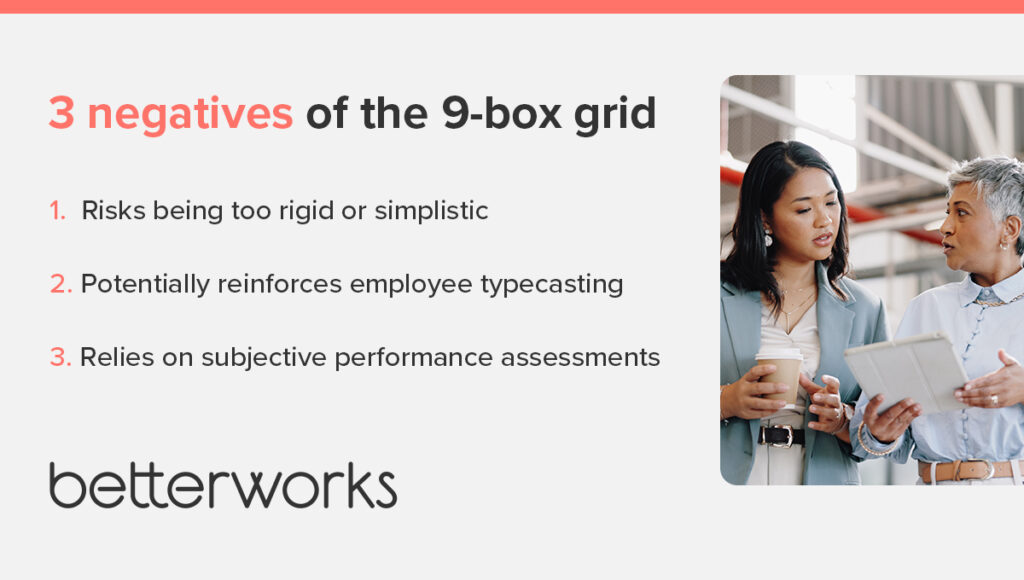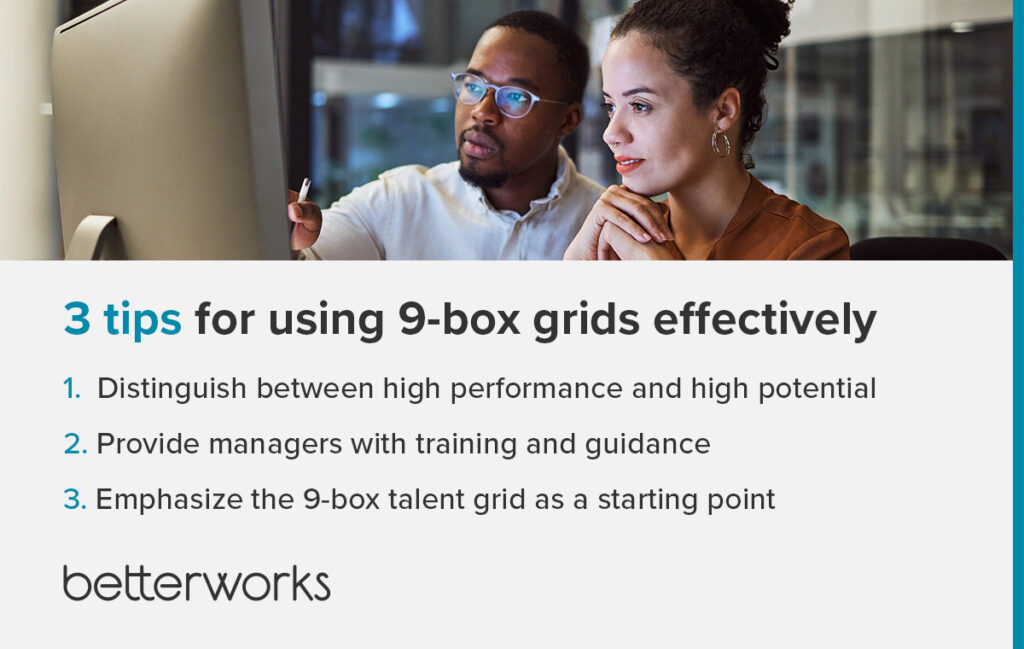When HR leaders need to understand their workforce’s current skills and future potential, they often turn to a 9-box talent grid. This popular tool provides a structured framework for evaluating employees based on their performance and potential, allowing HR professionals to understand their organization’s talent landscape.
But like any tool, the 9-box grid has limitations. HR leaders must help managers understand what the 9-box grid can and can’t do and then set clear guidelines for using it effectively.
Discover the pros and cons of using the 9-box talent grid — and how to evolve the model so managers can use it effectively for performance management.
What is a 9-box talent grid, and why is it popular?
The 9-box talent grid, also called the 9-box performance grid, is a visual tool for assessing employees based on performance in their current role and their potential for taking on greater responsibility. It consists of a three-by-three grid, with one axis representing performance levels (such as low, medium, and high) and the other axis representing potential (such as low, medium, and high).
The 9-box grid categorizes performers in top, mid, and low tiers, with low performers needing additional support or goals for improvement. Understanding each employee’s performance and potential informs performance management decisions such as promotions, rewards, and lateral career moves.
The 9-box performance grid is popular with many organizations because of its simplicity, clarity, and alignment with talent management systems. It offers managers a familiar and structured approach to performance management and talent development.
Many organizations have performance management systems that require evaluating and grouping employees based on performance and potential. The 9-box grid integrates well with these systems.
3 positives of the 9-box grid
The 9-box talent grid can help organizations seeking to improve their approach to performance and talent management. Here are three ways the 9-box grid can drive value in your HR programs and strategy.
Provides a simple visual framework for performance
The 9-box grid offers a clear and concise representation of your organization’s talent. The grid visually categorizes employees based on their performance and potential. At a glance, managers and leaders can diagnose and communicate the organization’s talent landscape.
“They get to see the visualization of the data,” says Rob Budzinski, vice president of professional services at Betterworks. “That helps them to understand their people better and compare them to other people within the organization.”
Streamlines talent identification and succession planning
Placing team members in a 9-box talent grid helps managers assess their available talent and communicate their assessment to HR and other managers. HR leaders can see, at a glance, the state of the workforce in terms of potential and performance. This helps in making informed decisions about succession planning, promotions, and talent allocation.
You can use the 9-box grid in succession planning to help identify high-potential individuals with the potential to take on leadership roles, either immediately or eventually. This helps HR wisely allocate resources for leadership development and succession planning.
Improves career planning and growth conversations
The 9-box talent grid serves as a talent mapping framework that can support meaningful career discussions between managers and employees. It provides a common language and structure to assess an individual’s performance and potential. The grid can be a starting point when helping employees explore internal mobility and career advancement.
For example, an employee may rank low in performance but demonstrate high potential. Their manager can kick off the conversation from there. Perhaps the job requirements aren’t a good fit for that person, or maybe it’s a matter of correcting deficiencies. Whatever the diagnosis, the manager and employee can use conversations, feedback, and goal-setting to craft an action plan. This might include a performance improvement framework or shifting into a more suitable role.

3 negatives of the 9-box grid
While the 9-box talent grid offers valuable insights for performance and talent management, there are potential drawbacks. Apply the 9-box with caution to prevent the following types of negative effects.
Runs the risk of being too rigid or simplistic
The 9-box talent grid provides a static snapshot of talent, which may not account for changes in performance or potential. It might not capture the dynamic nature of talent development. Rapid changes in the business or your people might not show up in a 9-box performance grid.
Similarly, the 9-box model necessarily restricts how you can categorize employee performance and potential, which can miss the complexity of talent assessment. Overrelying on the 9-box grid means you fail to recognize each individual’s range of skills, competencies, and potential, potentially affecting crucial talent decisions.
Reinforces employee typecasting
Using the 9-box grid approach can create the perception that employees are fixed in their current box, with limited opportunities for career growth and development.
One way a 9-box grid can create a self-fulfilling prophecy for employees. For example, a worker labeled as “low potential” might give up on their development or put less effort in. Meanwhile, managers might overlook them for challenging assignments or advancement opportunities, further limiting their chances to prove themselves and grow.
Train managers to use the 9-box model as a tool to help employees develop rather than as a punitive exercise.
Relies on subjective assessments of performance
The 9-box talent grid relies on subjective judgments by managers, which can introduce bias into the performance management process. Two managers may have different interpretations of performance and potential, leading to inconsistent evaluations and potentially unfair employee treatment. Some managers may be harder “graders” than others, leading to scenarios where two equally accomplished employees are rated differently.
“People don’t have well-defined definitions of what each box means,” says Nicolette Schumacher, program architect at Betterworks. “That’s where the real problem is.” Provide examples of what employees in each box might look like to help managers understand how to place and identify their reports.

Evolve your use of 9-box grids in talent management
Is the 9-box talent grid still relevant? The primary drawbacks of the 9-box model are a matter of perspective. “It happens when it’s a ‘look back’ process vs a ‘look forward’ process,” says Caitlin Collins, program strategy director at Betterworks.
Here are a few ways to take a future-oriented approach when using the 9-box model for talent development.
Implement continuous performance conversations
Continuous performance conversations allow for a more nuanced evaluation of an individual’s performance and potential. These conversations illuminate an employee’s strengths, growth opportunities, and career aspirations, providing the manager with a fuller understanding of their capabilities.
When managers have regular conversations with employees and incorporate them into goals and talent development plans, the 9-box grid becomes one more tool for guiding employee progress and development.
Take a data-rich approach to assessing potential
Analytics can help HR teams more accurately assess employee potential. To take a data-rich approach, however, you need an HR data strategy and robust technology for collecting and storing the information you need.
“Without the right technology, you’ve got information in disparate places that you’re trying to collect,” Caitlin says. “It becomes an insurmountable task, and not everything is going to be documented.”
Data-rich assessments can help identify specific development needs for employees, too, informing targeted growth plans.
Don’t limit yourself to performance and potential
One of the most common uses of the 9-box grid is for succession planning, which is an opportunity to innovate. You can use the 9-box grid to compare any two factors, Caitlin says, not just performance and potential. You can look at performance on one side and risk of loss on the other, for example, to develop a more targeted retention plan.
“When people start to diverge outside of potential and performance, they’re getting more into talent planning,” Caitlin says. A company that is entering a new market can use a 9-grid for workforce planning, to determine where there are organizational gaps that need to be filled. Another example is putting potential on one axis and the organization’s required skills on the other axis. This can help you identify the people best suited to fill talent gaps.
Empower transparent and accessible calibration
Calibration sessions facilitate continuous improvement of the 9-box model. By regularly reviewing and discussing the model’s effectiveness, organizations identify improvements, update evaluation criteria, and adapt the model to align with the organization’s evolving needs. Caitlin believes organizations should strive for simplicity, collecting only the data needed to meet the goals of the calibration process.

3 tips for using 9-box grids effectively
The 9-box model is only as effective as you are. Apply these tips to maximize its potential for talent evaluation, development, and planning.
Distinguish between high performance and high potential
Helping managers see the difference between performance and potential is critical to successfully using 9-box grids.
High-performing employees consistently exceed expectations and deliver exceptional results. When evaluating high performance, consider factors such as goal achievement, quality of work, productivity, and consistently meeting or exceeding performance standards. These employees have a history of success in their current roles. However, they may or may not be high-potential employees, much less want to take on higher-level responsibilities.
Team members with high future potential demonstrate the ability to take on ascending roles and responsibilities, including leadership positions. When evaluating high-potential candidates, consider factors such as adaptability, learning agility, leadership potential, and the ability to grow and develop in new or challenging situations. These employees may or may not have maximal performance, but they possess the qualities and attributes that indicate the potential for senior roles.
Focus on giving high-potential employees more challenging tasks, mentorship, and training so they can keep improving and preparing for leadership positions. Similarly, employees with high performance but limited potential can grow in their current roles without being pressured to take on responsibilities that aren’t the right fit.
Provide managers with training and guidance
Support from HR goes a long way in helping managers turn the 9-box into a useful, future-focused exercise. Start by educating managers on the grid’s purpose and criteria, as well as having meaningful discussions with employees based on their placement. Well-trained managers will result in better talent decisions.
Managers often struggle to comprehend each box’s meaning and how to accurately assign workers. “If you place someone in the top-right box, what does that really mean? What are you saying about their behaviors, their skill set?” Nicolette says. “If someone’s in the lower box, does that mean they should be counseled into a different role? It’s the guidance that goes with it that makes it meaningful.”
Emphasize the 9-box talent grid as a starting point
While the 9-box grid is a valuable tool, it’s not the sole determinant. To find the best people for each role, make sure they consider other factors, such as individual aspirations, career goals, and organizational needs. Use the grid as a guide, not a rulebook.
“It’s a guideline to better understand where people fit,” Nicolette says. “And it’s not something they’re stuck in forever: it could change in three months.”

Apply technology to 9-box talent grid processes
Technology can make the 9-box talent grid even more effective. “Good technology will be able to very easily give you more objective data on how people show up throughout the year versus a point in time,” Caitlin says. AI-powered analytics and data-driven insights can provide a more objective and comprehensive evaluation of employees, minimizing bias and maximizing the accuracy of talent assessments.
The more data you have, the more you can learn about your workforce. “You get way more insight because you have all this additional data to give you context of what you’re looking at through the filters,” Nicolette says. “It tells you more of a story.”
When powered by the right technology, you can use the 9-box talent grid to evaluate your workforce today while setting the course for growth.
Want to learn more? Check out our guide to talent management frameworks.
Maximize employee potential with a talent management framework guide






